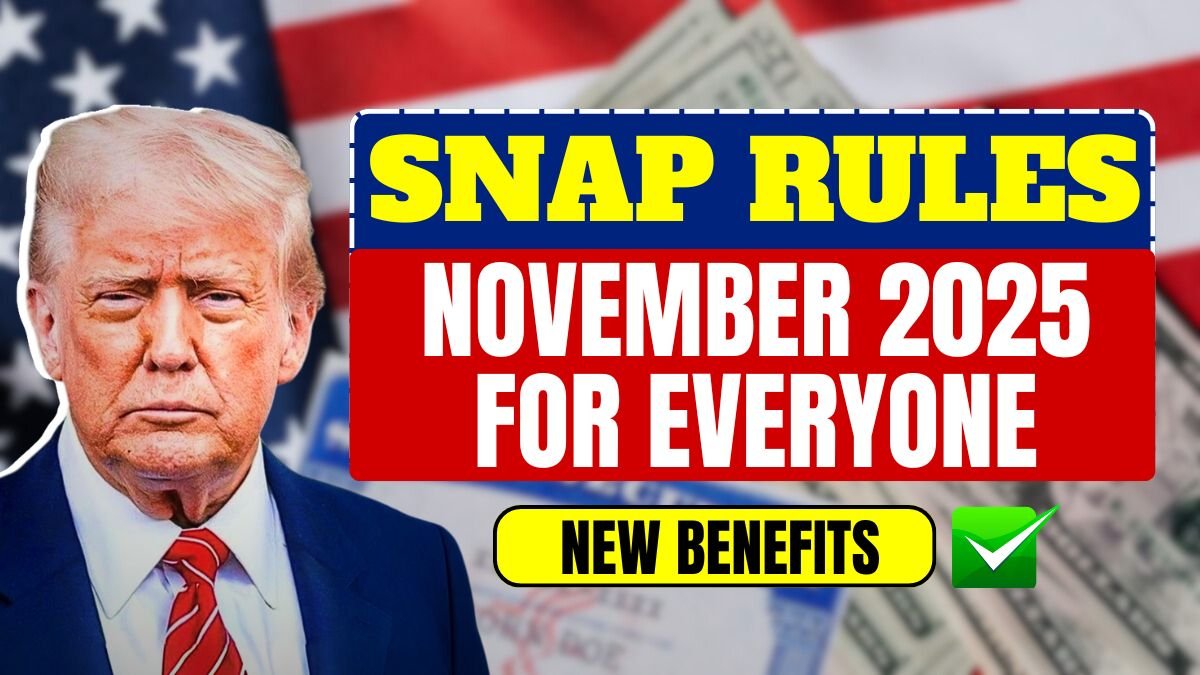The United States’ Supplemental Nutrition Assistance Program (SNAP), formerly known as the “Food Stamp Program,” serves as a lifeline for millions of low-income families across the country. This program ensures everyone has access to nutritious food, regardless of their financial situation. In November 2025, the USDA (U.S. Department of Agriculture) announced new SNAP guidelines and regulations that will directly impact beneficiaries nationwide.
The new changes aim to provide food assistance to more people, simplify eligibility criteria, and increase benefit amounts while accounting for inflation. Let’s take a closer look at the new SNAP rules, eligibility requirements, and benefits that will take effect in November 2025.
A Glimpse of the New SNAP Rules for November 2025
The new SNAP rules, effective in November 2025, introduce some significant changes. These changes are aimed at providing relief to families living below the poverty line, especially those struggling with rising inflation and employment instability.
The USDA has revised the eligibility criteria for the SNAP program to allow more people to access benefits. The monthly benefit amount for each family has also been increased. Some states have even integrated local food support programs into SNAP benefits, providing even more assistance to those in need.
New Eligibility Requirements: Who is Now Eligible for SNAP?
Several updates have been made to SNAP eligibility after November 2025. Previously, only individuals with limited incomes and certain categories of individuals were eligible for this assistance, but now the eligibility criteria have been expanded.
Now, any individual or family earning 135% or less of the Federal Poverty Line can apply for SNAP. Previously, this limit was only up to 130%. This means that more middle-class workers and low-income families will now be eligible for the program.
In addition, the eligibility process has been simplified for seniors (over 60 years of age), individuals with disabilities, and single-parent households. Applicants in these categories are now relieved of additional documentation hassles.
New Income Limits and Cutoff Levels
The USDA has also updated the SNAP income limits for 2025. These limits are determined based on family size and location. For example, if a person’s monthly income is less than $1,945, they can qualify for SNAP benefits while living alone. For a family of four, the limit is approximately $4,025.
These changes will directly benefit those whose incomes have risen slightly in line with inflation, but whose cost of living has risen much more than that.
Increased Benefit Amount – More Food Assistance Will Be Available
The SNAP benefit amount has also been increased by 3.5% to 5% starting in November 2025. This revision is primarily based on the Cost of Living Adjustment (COLA).
For example, previously, an average individual received $202 per month in food assistance, which has now increased to approximately $215–$220. A family of four previously received $835, which has now increased to between $880–$900 per month.
This increase reflects the government’s commitment to ensuring everyone has access to nutritious food, regardless of rising food prices.
What will the new SNAP benefits include?
The new SNAP updates for 2025 expand not only the amount but also the types of benefits. SNAP cardholders will no longer be limited to grocery stores, but will also be able to access a number of new benefits.
Snap benefits now include online grocery shopping, shopping at farmers markets, and, in some states, ready-to-eat meals.
In addition, in some states, SNAP cards can also be used on local food delivery apps. This will be especially useful for elderly and disabled individuals who cannot go shopping.
Relief for Youth and the Unemployed
Previously, SNAP had strict work requirements for Able-Bodied Adults Without Dependents (ABAWDs), meaning adults aged 18 to 52 without dependents.
However, the November 2025 update has relaxed these rules somewhat.
Unemployed youth have now been granted some relief from the requirement to find work to receive SNAP benefits, especially in areas with low employment rates.
Additionally, the government has integrated SNAP benefits with work training programs to help beneficiaries become self-reliant in the future.
Special Provisions for Senior Citizens and Persons with Disabilities
The November 2025 SNAP update also introduced several positive changes for senior citizens and persons with disabilities.
These categories will no longer be required to submit additional documentation during the application process. Furthermore, their income limits have been relaxed by up to $200, making it easier for them to access benefits.
In addition, some states have also begun providing direct assistance to senior citizens through the Monthly Nutrition Box or Home Delivery Meal Program.
Simplified Digital Changes to the SNAP Application Process
The USDA has implemented digital improvements to make the SNAP application process more simple and transparent.
Applicants can now apply for SNAP, upload documents, and track their application status through an online portal or mobile app.
State-Level Changes and Local Support
Although SNAP is a federal program, each state implements it according to its local rules and requirements.
After November 2025, several states have launched their own local SNAP expansion programs. For example, California and New York have launched the “Healthy Families Bonus” program, which offers additional points for purchasing fresh fruits and vegetables.
Texas and Florida have launched the SNAP on Wheels service for rural areas.
The aim of all these initiatives is to ensure that no one goes to bed hungry and every family has access to nutritious food.
Conclusion: Impact of the November 2025 SNAP Changes
Overall, the November 2025 SNAP rules have given millions of Americans new hope for relief.
This update not only broadens eligibility but also ensures food security for every segment—young, elderly, unemployed, and disabled.
In an era of inflation and rising living costs, this program is proving to be a support for both the poor and middle-income groups.
With a digital application process and new benefits, SNAP is no longer just an assistance program, but an economic security blanket that gives every citizen the opportunity to live a dignified life.
FAQs
1. What is SNAP?
A.



